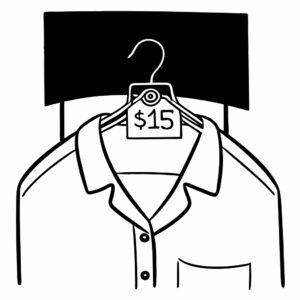Question More, Action Knowledge.
Remember, at QMAK, we don’t just teach; we empower. We don’t just inform; we inspire. We don’t just question; we act. Become a Gold Member, and let’s unlock your child’s full potential, one question at a time.
By the end of this lesson, students will:
Understand the concept of opportunity cost in decision-making.
Learn to identify what is sacrificed when making a choice.
Recognize how considering opportunity costs leads to better decisions.
Apply the concept to personal and academic scenarios.

Think about yesterday. I bet you made lots of choices – some big, some small. Every time you chose to do something, you also chose not to do something else. Let’s explore what that means.
Imagine you saved up $20. You’re at the store looking at two things you really want: a new book in your favorite series and a cool game for your phone. You can only buy one – if you choose the book, you can’t get the game. If you choose the game, no book.

This is something really interesting about choices – they’re not just about what we get, they’re also about what we give up. When we pick one thing, we have to say “no” to something else. That thing we say “no” to? That’s what we call an “opportunity cost.”
Let me share a choice I had to make recently. I could either:
I chose to exercise. That means I gave up watching my show – that was my opportunity cost. Was it worth it? Well, that’s what we’re going to learn to figure out today!
Now it’s your turn. Think about a choice you made recently:
Today we’re going to learn why thinking about what we give up (our opportunity costs) helps us make better choices. Because sometimes what we’re giving up is more important than what we’re getting!
Teaching Note: This opening helps students recognize that they’re already experiencing opportunity costs in their daily lives, even if they didn’t know the term. It sets up the more detailed exploration to come.
Let me tell you about Maya and her summer ice cream stand. Maya loved making special ice cream flavors, and she had a great idea: she would open an ice cream stand in her neighborhood of Sunset Valley. She used her savings to buy supplies and spent weekends learning how to make the perfect ice cream.
But there was a problem. Sunset Valley was pretty quiet, and not many people walked by her stand. Even worse, most of her neighbors were on special diets or preferred frozen yogurt. After trying for two months, Maya was only making enough money to buy new supplies – no extra for her savings.
Here’s where it gets interesting. Maya kept thinking, “Well, I’ve already spent so much time learning to make ice cream. I’ve already bought all these supplies. I should keep going.” She stayed open three days a week after school, which meant she couldn’t join the robotics club she was interested in or help her friend start a dog-walking business.
Let’s think about Maya’s situation:

What do you think Maya was giving up by continuing with her ice cream stand? What could she have done instead with:
What would you tell Maya if she were your friend? Sometimes it’s easier to see the right choice when we’re helping someone else make a decision.
Here’s something to think about: Just because we’ve spent time or money on something doesn’t mean we have to keep doing it. What matters is what opportunities are available to us right now, and what we might be missing by not taking them.
Have you ever been in a situation like Maya’s, where you kept doing something just because you’d already started it? What did you give up by continuing?
Teaching Note: This story helps students understand opportunity costs through a relatable scenario. It shows how emotional attachment to past investments can blind us to better current opportunities.

The really important thing about opportunity cost is that it helps us make better decisions by making us think about what we’re giving up. Sometimes when we think about what we’re losing, we realize our first choice might not be our best choice.
This is different from what we learned about last time with probabilities. With probabilities, we were thinking about what might happen. With opportunity cost, we’re thinking about what definitely won’t happen because we chose something else.
Let’s practice! Think about a choice you’ll need to make today:
This kind of thinking helps you make choices you won’t regret later.
Teaching Note: Students often find it easier to understand opportunity cost when it’s related to their daily choices. Using examples of time and money – resources that are limited and familiar to them – helps make the concept concrete.
First Scenario: The Big Game vs. Family Time
Imagine this: Your soccer team has made it to the championship game, but it’s on the same day as your cousin’s wedding. You can only choose one.
Let’s break down what you give up with each choice:
If you choose the game:
* Missing a special family memory
* Disappointing relatives
* Not seeing your cousin’s big day
* Missing the party and celebration
If you choose the wedding:
* Missing your team’s biggest game
* Letting down your teammates
* Possible lost opportunity for a championship
* Missing the celebration if your team wins
Which would you choose? Why? What’s the most important thing you’d be giving up?
Second Scenario: The Birthday Money Decision
You just got $50 for your birthday. You could:
Let’s map out what you give up with each choice. For example, if you buy the game:
Which choice has the biggest opportunity cost for you?
Third Scenario: The After-School Choice
Your friend needs help preparing for a math test, but you also have soccer practice. You can only do one.
Think about:
For each scenario, let’s write down:
Remember: There’s usually no perfect choice – every decision means giving something up. The key is understanding what you’re giving up and deciding if it’s worth it.

Teaching Note: Help students see that opportunity costs aren’t just about money – they can involve time, experiences, relationships, and personal growth. Guide them to think deeply about what matters most to them in each scenario.
Now it’s time to think about choices in your own life. Let’s look at a decision you made recently and figure out what you gave up to make that choice.
# My Decision and Its Opportunity Costs
*Understanding what we give up when we make choices*
Name: _________________
## About My Decision
📅 Date of decision: _________________
### What was your decision about?
Describe the choice you had to make:
________________________________________
________________________________________
________________________________________
### What made this a hard choice?
________________________________________
________________________________________
## My Options
List all the choices you had:
1. __________________________________
2. __________________________________
3. __________________________________
4. __________________________________
## What I Chose
### I decided to:
________________________________________
### I chose this because:
________________________________________
________________________________________
## What I Gave Up
### The next best thing I could have done was:
________________________________________
### By making my choice, I gave up:
- Time? ______________________________
- Money? ____________________________
- Experience? ________________________
- Other? ____________________________
## Looking Back
### Rate your decision:
Circle one: 😊 😐 😕
### Would you make the same choice again?
○ Yes
○ No
○ Maybe
### Why or why not?
________________________________________
________________________________________
## What I Learned
### This experience taught me:
________________________________________
________________________________________
### Next time I make a similar choice, I will:
________________________________________
________________________________________
## Opportunity Cost Summary
The biggest thing I gave up (my main opportunity cost) was:
________________________________________
Was it worth it? ___________________________
Remember, every choice means giving something up. Understanding what we give up helps us make better decisions next time!
Teaching Note: This personal reflection helps students connect the concept of opportunity cost to their own lives and decisions. The goal is to make the concept practical and useful for future decision-making.
Today we explored something really important in decision-making – opportunity costs. We learned that every time we choose something, we’re also choosing NOT to do something else. Understanding what we give up helps us make better choices.
Remember Maya and her ice cream stand? She taught us that sometimes we keep doing something just because we’ve already put time or money into it, even when there might be better opportunities waiting for us.
Let’s review what we discovered:
Over the next week, become an “Opportunity Cost Detective.” Keep track of the choices you make and what you give up for each one. Use your worksheet to help you think through each decision.
For example, you might write:
“Today I chose to practice piano instead of playing video games. My opportunity cost was missing game time with my friends. It was worth it because I’m getting better at piano, but next time I might plan my practice for when my friends aren’t online.“

When we meet next time, we’ll learn about something fascinating – sunk costs. Bring your opportunity cost diary – I’d love to hear how thinking about what you give up helped you make choices!
Remember: There’s no such thing as a free choice – everything costs us something. The key is making sure what we get is worth what we give up.
What was your biggest insight about opportunity costs today? What decision coming up in your life might you look at differently now?
This wrap-up reinforces the key concepts while setting up anticipation for the next lesson on sunk costs. The take-home challenge encourages practical application of opportunity cost awareness in daily life.
Verse 1:
Every yes means saying no
To something else that had to go
Like Maya’s ice cream summer stand
Took time she could have had in hand
For robotics, walking dogs
Or other paths not yet explored
Pre-Chorus:
Look at what you’re giving up
(Before you make your choice)
Sometimes what we leave behind
(Might have been the better voice)
Chorus:
What we give up matters too
Not just what we choose to do
Every path not taken shows
Another way our life could go
Think it through before you choose
See what you might have to lose
Verse 2:
Time and money, dreams and play
Each choice takes something else away
So when you face that crossroad clear
Think of all that brought you here
But don’t let past investments hold
Your future stories left untold
(Pre-Chorus)
(Chorus)
Bridge:
Sometimes saying no today
Opens doors for tomorrow
So count the cost of every choice
And choose with care to follow
(Chorus)
Outro:
Every choice has something more
Hidden in its shade
Make sure what you’re giving up
Is worth the choice you made
Remember, at QMAK, we don’t just teach; we empower. We don’t just inform; we inspire. We don’t just question; we act. Become a Gold Member, and let’s unlock your child’s full potential, one question at a time.